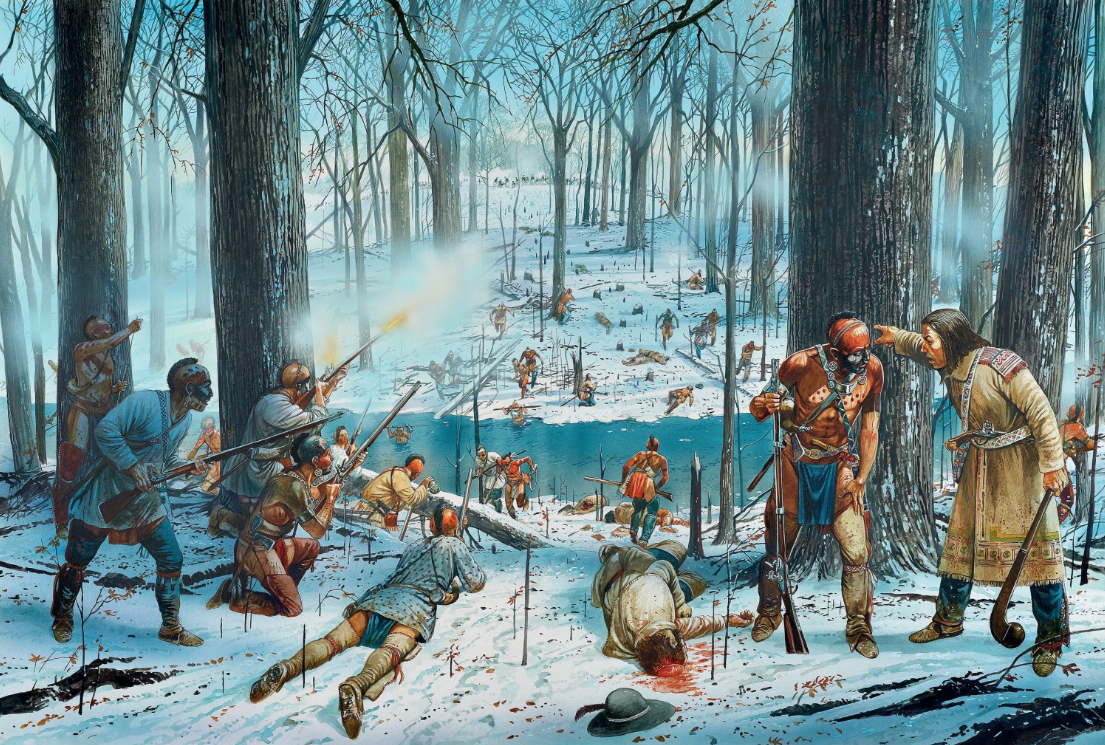On 4 November 1791 Native Americans and US Army forces clashed at the battle of the Wabash. The fighting that followed ended in crushing defeat for Arthur St Clair's forces, with the Native Americans securing their greatest ever victory over the US army.
The Wabash Ravine, November 4 1791, 7.15AM
Extract from Campaign 240: Wabash 1781 by John F Winkler
At 6.45am, attacking Indians quickly overran the Kentucky militia camp. The surviving militiamen then fled down an Indian trail into the ravine through which the Wabash River flows. Across the river, the militiamen reached the end of St Clair’s Trace, which they followed up the other side of the ravine to the ridge on which the American army was encamped. Indians pursuing the militiamen attacked the camp, but were driven back.
This artwork shows the scene a half hour after the first Indian attack. Indians now surround the camp. Those in the foreground are Miami Indians, in positions across the Wabash from the end of St Clair’s Trace. Miamis behind trees and on the ground are firing muskets at American soldiers on the ridge. To their right lies a Kentucky frontiersman, who has been overtaken and scalped. Ahead, before the Wabash, and along St Clair’s Trace, the bodies of other dead Kentucky militiamen can be seen. To their right and left, Miamis are returning from their attack on the camp. On the ridge, the three 6-pdr guns of Captain Mahlon Ford’s Company have begun firing at the Miamis. The tree branches above and ahead of the Miamis are shaking, as balls from fired American artillery canisters strike them about every ten seconds. To the left of the guns, which are aimed too high to harm the Miamis, are soldiers of Major John Clark’s Western Pennsylvania Battalion. To the right are those of Major Thomas Butler’s Eastern Pennsylvania Battalion. In the right foreground is the Miami commander William Wells. Captured by the Miami as a boy, Wells was the brother of Captain Samuel Wells, a Kentucky militia commander who survived the Indian attack. Wells is listening to a British officer, one of two from the 24th (2nd Warwickshire) Regiment of Foot covertly sent from the Detroit garrison to advise the Indians. The officer, who is wearing the winter coat of an Ojibwe warrior and carrying an Ojibwe war club, is urging him to advance the Miami line closer to the American artillery.
Further Reading
If you'd like to read more about the battle of the Wabash take a look at Campaign 240: Wabash 1791 by John F Winkler. Other books looking at conflicts between Native Americans and the US army include Campaign 256: Fallen Timbers 1794 and Campaign 287: Tippecanoe 1811.



Comments
You must be logged in to comment on this post. Click here to log in.
Submit your comment